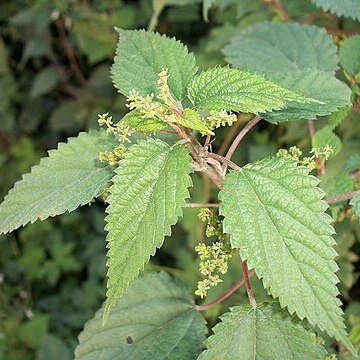Annual herb, monoecious, or dioecious by abortion. Stems soft, decumbent or scrambling, sometimes rooting at lower nodes, up to 1.5 m long, with few to fairly many ±1 mm long stinging hairs, stiff hairs sometimes present when young. Leaves lanceolate to ovate, 17-125 x 11-77 mm, apical tooth longer than broad, base rounded, truncate or rarely cordate, with long stinging hairs scattered above and on veins of lower surface, with stiff hairs; petiole 6-115 mm long, with stiff hairs and sometimes with stinging hairs, these occasionally mounted on short, slender protuberances without decur-rent base; stipules as in L. alatipes but 4-10 x 1-2 mm. Inflorescence paniculate, mostly with flowers in small cymose clusters; female in upper axils, usually repeatedly dichotomously branched, or with one branch taking the lead over the other, up to 110 mm long; peduncles glabrous or with stinging hairs; male in lower axils, up to 35 mm long, often with two or more glomerules of equal size terminating the branches; peduncles as in female. Female flowers pedicellate, 1-2 mm long. Male flowers 5-merous, shortly pedicellate; pedicel with a narrow dorsiventral wing, 1.75-3.0 mm in diameter. Achenes almost sessile, laterally compressed, centre of flattened sides waited, with smooth circular marginal ridge, ±1.5 mm long, dispersed with perianth attached.
Annual herb, 0.5-1.5 m high; monoecious. Leaves triangular to rhomboid, stiff hairs above, stiff hairs on veins below, base truncate, apex acuminate, margins serrate, up to 25 teeth; petioles up to 110 mm long, glabrous; stipules linear-lanceolate, up to 10 mm long. Inflorescences small cymose clusters, usually dichotomously branched; male inflorescence in axils of lower leaves, up to 35 mm long; female inflorescence in axils of upper leaves, up to 110 mm long. Male flowers of 2 or more glomerules, with narrow dorsiventral wing. Female flowers in small dichasial clusters. Flowering time Jan.-Mar. Fruit sessile, ovoid achenes, ± 1.5 mm long, with smooth, circular, marginal ridge.
A herb. It is slender and often grows as an annual. It grows 3 m high. It can be scrambling. It has a few stinging hairs. The leaves are alternate and widely spaced. The leaf blades are 12 cm long by 6 cm wide. The stalks can be 8 cm long. There are teeth along the edge and the leaf tapers to the tip. The leaves are pale underneath. The flowers are green. They are in small clusters.
Leaves restricted to upper part of stem at anthesis, up to 10 x 7 cm., triangular to rhomboid or ovate; apex acuminate; base cuneate, truncate or subcordate; margin coarsely to finely serrate with 5–25 teeth per side less than 5 mm. long; lamina upper surface with short, stiff hairs or subglabrous, lower surface with stiff hairs on the nerves or subglabrous.
Male inflorescences in lower axils, on peduncles 1–3 cm. long; flowers in few, dense cymose clusters c. 1 cm. in diam.; pedicels c. 1 mm. long with a narrow dorsi-ventral wing; perianth with 5 strongly corniculate tepals, 5 stamens, and a small pistillode.
Inflorescences single and usually restricted to upper leaf axils, unisexual, paniculate, usually dichotomously branched, with many flowers in small cymose clusters or with a few flowers on each branch, with scattered stiff or stinging hairs.
Stems soft, ± erect, decumbent or scrambling, sometimes rooting at lower nodes, up to 1.5 m. long, unbranched or branching from the bases, glabrescent or covered with few to numerous stinging hairs, sometimes on raised protuberances.
Female flowers in small dichasial clusters c. 6 mm. in diam.; pedicels c. 1 mm. long with a narrow dorsi-ventral wing; tepals 4, c. 1 mm. long, the dorsal and ventral ones much smaller than the lateral ones.
Monoecious, scrambling to creeping annual to 1.5 m, woody at base, young plants with small, stinging hairs. Leaves ovate, thin-textured, finely serrate. Flowers in axillary panicles, small, greenish.
Achene c. 1.5 mm. long, ovoid, laterally compressed, with a ridge enclosing a rugose depression on each side, shed with the perianth.
Stipules up to 10 mm. long, linear-lanceolate, fused for about half their length, with a few stiff hairs.
Annual or short-lived perennial, erect or ascending herbs, monoecious or dioecious by abortion.
Petiole 2–6(11) cm. long, glabrous to puberulous.

